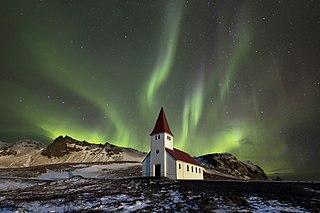
An aurora , also commonly known as the northern lights or southern lights, is a natural light display in Earth's sky, predominantly seen in high-latitude regions. Auroras display dynamic patterns of brilliant lights that appear as curtains, rays, spirals, or dynamic flickers covering the entire sky.

Finland attracted over 6.8 million foreign tourists in 2018, with 53 percent coming from other European Union states. In 2017, the value added by tourism was about 4.6 billion euros, or 2.6% of the Finnish GDP, providing approximately 140,200 jobs.

A wreath is an assortment of flowers, leaves, fruits, twigs, or various materials that is constructed to form a circle.

The Jäger Movement consisted of volunteers from Finland who trained in Germany as Jägers during World War I. Supported by Germany to enable the creation of a Finnish sovereign state, the movement was one of many means by which Germany intended to weaken Russia and to cause Russia's loss of its western provinces and dependencies.

Aurora is a Russian protected cruiser, currently preserved as a museum ship in Saint Petersburg. Aurora was one of three Pallada-class cruisers, built in Saint Petersburg for service in the Pacific. All three ships of this class served during the Russo-Japanese War. Aurora survived the Battle of Tsushima and was interned under US protection in the Philippines, and eventually returned to the Baltic Fleet. One of the first incidents of the October Revolution in Russia took place on the cruiser Aurora, which reportedly fired the first shot, signalling the beginning of the attack on the Winter Palace.

Laurus nobilis is an aromatic evergreen tree or large shrub with green, glabrous (smooth) leaves. It is in the flowering plant family Lauraceae. It is native to the Mediterranean region and is used as bay leaf for seasoning in cooking. Its common names include bay tree, bay laurel, sweet bay, true laurel, Grecian laurel, or simply laurel. Laurus nobilis figures prominently in classical Greco-Roman culture.

Chud or Chude is a term historically applied in the early East Slavic annals to several Finnic peoples in the area of what is now Estonia, Karelia and Northwestern Russia.

The emblems of the constituent republics of the Union of Soviet Socialist Republics all featured predominantly the hammer and sickle and the red star that symbolized communism, as well as a rising sun, surrounded by a wreath of wheat. The USSR State motto, Workers of the world, unite!, in both the republic's language and Russian was also placed on each one of them. In addition to those repetitive motifs, emblems of many Soviet republics also included features that were characteristic of their local landscapes, economies or cultures.

The state emblem of Uzbekistan was formally adopted on July 2, 1992 by the newly establish Republic of Uzbekistan. It bears many similarities to the emblem of the previous Uzbek SSR, which Republic of Uzbekistan succeeded. Like other post-Soviet republics whose symbols do not predate the October Revolution, the current emblem retains some components of the Soviet one. Prior to 1992, Uzbekistan had an emblem similar to all other Soviet Republics, with standard communist emblems and insignia.

An Aerosledge is a propeller-driven sledge, sleigh or toboggan which slides on runners or skis. Aerosleds are used for communications, mail deliveries, medical aid, emergency recovery, and patrolling borders in countries such as northern Russia, as well as for recreation. Aerosani were used by the Soviet Red Army during the Winter War and World War II.
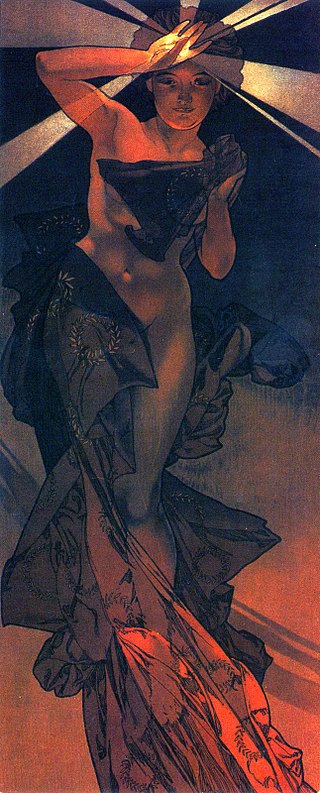
Aurora is a feminine given name, originating from the name of the ancient Roman goddess of dawn Aurora. Her tears were said to turn into the morning dew. Each morning she traveled in her chariot across the sky from east to west, proclaiming renewal with the rising of the sun. The Romans also associated the Northern Lights, or the Aurora borealis, with the goddess. Aurora is also traditionally the name of the princess in the fairy tale Sleeping Beauty and the many works of art it has inspired. The tale of a cursed princess who slept for one hundred years and was awakenened by the kiss of a prince might be considered a modern retelling of the ancient story of Aurora the dawn goddess, whose myths also include stories of a long sleep and an awakening at dawn.
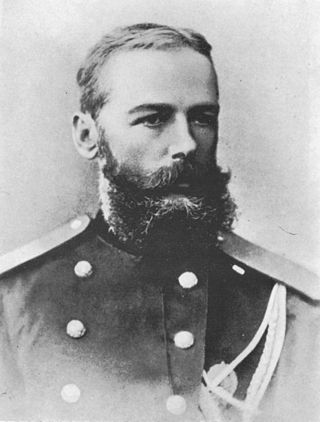
August Alexander Järnefelt was a Finnish general, topographist, governor and senator.
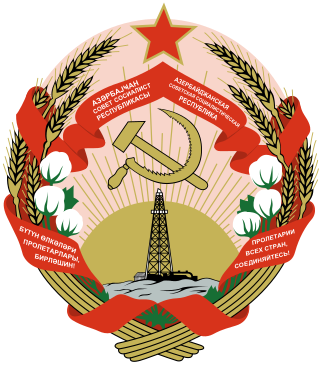
The national emblem of the Azerbaijan Soviet Socialist Republic was adopted in 1937 by the government of the Azerbaijan Soviet Socialist Republic. The style is based on the emblem of the Soviet Union.

The State Emblem of the Tajik Soviet Socialist Republic was adopted on March 1, 1937 by the government of the Tajik Soviet Socialist Republic. The emblem is based on the State Emblem of the Soviet Union. It shows symbols of agriculture. The red star is prominently featured with a small hammer and sickle within it. The rising sun stands for the future of the Tajik nation, and the star as well as the hammer and sickle for the victory of communism and the "world-wide socialist community of states". The emblem was replaced with the new emblem in 1992, which uses a similar design to the Soviet one. It was, however, was replacing the red banner with the current national flag, the big red star was replaced by the mountains, represents Pamir, the Samanid dynasty crown, and added the Quran book at below. It represents Islam as the official religion.

Sámi languages, in English also rendered as Sami and Saami, are a group of Uralic languages spoken by the Sámi people in Northern Europe. There are, depending on the nature and terms of division, ten or more Sami languages. Several spellings have been used for the Sámi languages, including Sámi, Sami, Saami, Saame, Sámic, Samic and Saamic, as well as the exonyms Lappish and Lappic. The last two, along with the term Lapp, are now often considered pejorative.

The Arctic Circle is one of the two polar circles, and the most northerly of the five major circles of latitude as shown on maps of Earth at about 66° 34' N. Its southern equivalent is the Antarctic Circle.
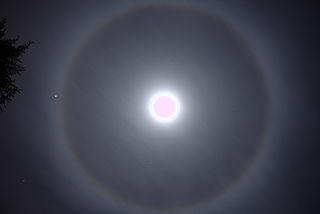
Optical phenomena are any observable events that result from the interaction of light and matter.
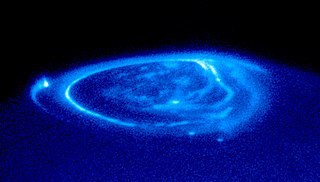
UVS, known as the Ultraviolet Spectrograph or Ultraviolet Imaging Spectrometer is the name of an instrument on the Juno orbiter for Jupiter. The instrument is an imaging spectrometer that observes the ultraviolet range of light wavelengths, which is shorter wavelengths than visible light but longer than X-rays. Specifically, it is focused on making remote observations of the aurora, detecting the emissions of gases such as hydrogen in the far-ultraviolet. UVS will observes light from as short a wavelength as 70 nm up to 200 nm, which is in the extreme and far ultraviolet range of light. The source of aurora emissions of Jupiter is one of the goals of the instrument. UVS is one of many instruments on Juno, but it is in particular designed to operate in conjunction with JADE, which observes high-energy particles. With both instruments operating together, both the UV emissions and high-energy particles at the same place and time can be synthesized. This supports the Goal of determining the source of the Jovian magnetic field. There has been a problem understanding the Jovian aurora, ever since Chandra determined X-rays were coming not from, as it was thought Io's orbit but from the polar regions. Every 45 minutes an X-ray hot-spot pulsates, corroborated by a similar previous detection in radio emissions by Galileo and Cassini spacecraft. One theory is that its related to the solar wind. The mystery is not that there are X-rays coming Jupiter, which has been known for decades, as detected by previous X-ray observatories, but rather why with the Chandra observation, that pulse was coming from the north polar region.
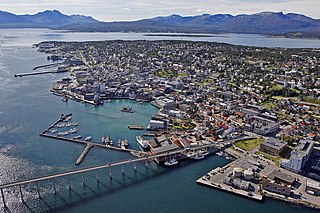
Tromsø is a city in Tromsø Municipality in Troms og Finnmark county, Norway. The city is the administrative centre of the municipality as well as the administrative centre of Troms county. The Diocese of Nord-Hålogaland and its Bishop are based at the Tromsø Cathedral in the city. The city is located on the island of Tromsøya which sits in the Tromsøysundet strait, just off the mainland of Northern Norway. The mainland suburb of Tromsdalen is connected to the city centre on Tromsøya by the Tromsø Bridge and the Tromsøysund Tunnel. The suburb of Kvaløysletta on the island of Kvaløya is connected to the city centre by the Sandnessund Bridge.























